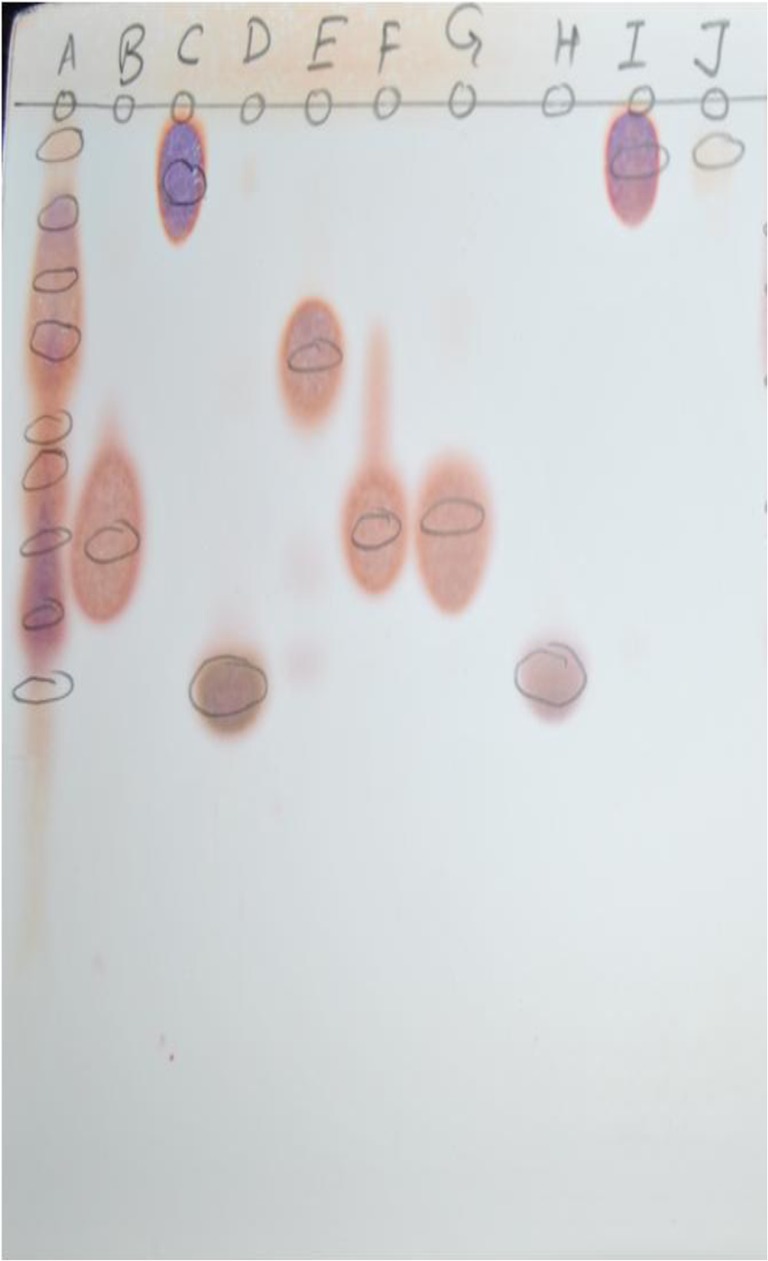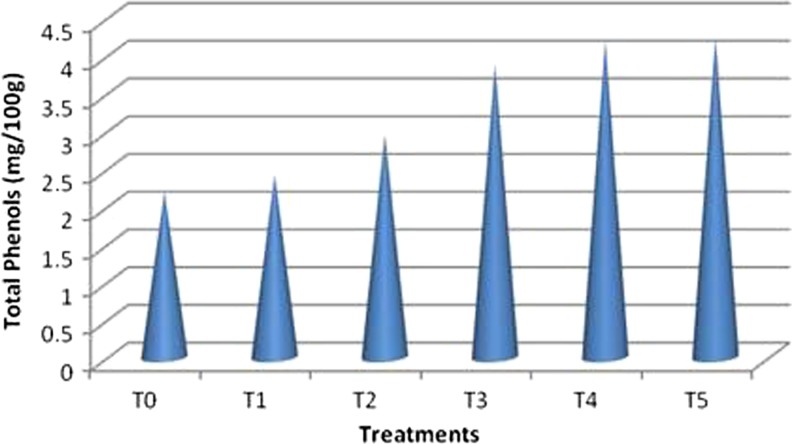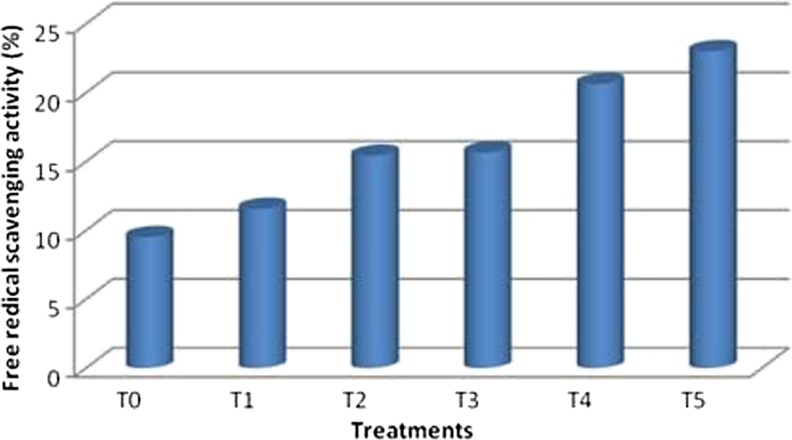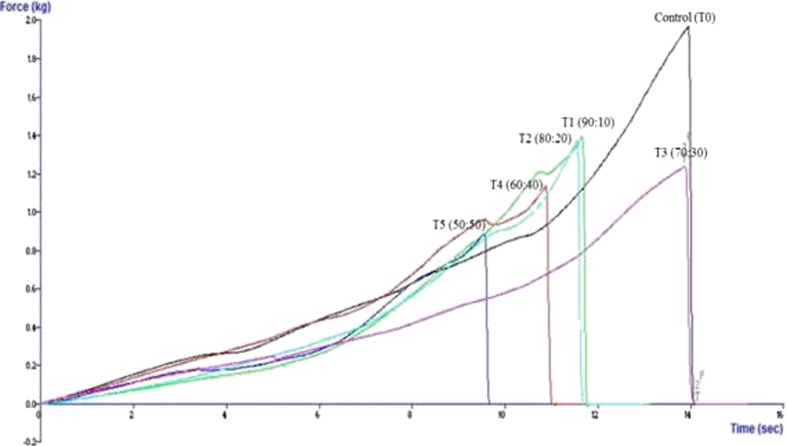Abstract
Nuggets popularly known as warrian is the traditional household food item of India and prepared from black gram but deficit in essential amino acid, lysine. Present study conducted to prepare lysine enriched nuggets using white button mushrooms (WBM) that contain all the essential amino acids. Black gram paste was fortified with WBM 0 (T0) to 50 at 10 % increments (T1 to T5). Moisture, ash, crude protein and fat were increased in T0 to T5 ranged from 10.00 to 13.52 %, 4.00 to 4.18 %, 13.90 to 23.80 % and 0.37 to 1.00 %, respectively. The cooking weight, cooking losses and antioxidant activity (as DPPH) were increased with increase in WBM (lysine enrichment) in nuggets. In textural analysis, hardness decreased with increases fortification from 1.971 to 0.889 kg. Based on physico-chemical, cooking and textural properties, black gram to WBM ratio of 80: 20 was recommended.
Keywords: Nuggets (warrian), Mushroom, Antioxidants, Cooking quality, Hardness
Introduction
Plant protein products are gaining increased interest as ingredients in food systems throughout the world, because of their versatile functional properties or as biologically active components. Besides essential nutrients, they have lower cholesterol level and incorporate better fiber in the diet (Marcello and Gius 1997, Sirtori and Lovati 2001). Nuggets popularly known as warrian in Indian household, is prepared commonly from black gram and are rich source of protein, but lacks in a few essential amino acids, fibers and antioxidant properties. Seldom efforts were focused on improving the nutritional value of the nuggets although they are traditionally part of a meal in India. White button mushrooms, which are rich in lysine and other essential amino acids, are widely grown throughout world and are highly perishables and spoil within 24 h (Chang 1999; Singh et al. 1999; Boa 2004; Antmann et al. 2008). The surplus produce can be utilized to prepare or fortify traditional based culinary and other enriched food items (Mattila et al. 2000). Nuggets are prepared by acting it (whipping) for proper consistency and density. Small droplets of the batter is placed on an oil smeared plate and dried under sun. The final product is crispy with hallow inner core. It is assumed that proper shape and texture of nugget is directly related with the consistency of the batter by adjusting the moisture content and level of aeration. Improving the textural and functional properties of nuggests is needed for biphasic advantage in storage and quality. The present study was conducted with an objective to prepare and standardize an acceptable lysine enriched nuggets by mushroom fortification.
Material and methods
Raw materials
Black gram, black pepper and salt were obtained from local market while the white button mushrooms were procured from the department of Mycology and Plant Pathology, Dr Y S Parmar University of Horticulture and Forestry, Solan (INDIA).
Fortification of nuggets
Black gram thoroughly washed and soaked in double the amount of water for 12 h. After draining and washing, the dal was ground to paste by using household grinder. Mushrooms were blanched for 5 min and made into paste by grinding. Nuggets (wariana) were prepared by mixing dal paste with 0.5 % black pepper and 0.5 % salt. Nuggets without mushroom paste (100:0) was taken as control and compared with other treatments replacing the dal paste with mushroom paste ranging from 10 to 50 %. Thus the different combinations were as T0 (Control, no mushroom), T1 (90:10), T2 (80:20), T3 (70:30), T4 (60:40) and T5 (50:50).
Physico-chemical analysis
Moisture (%), ash (%), crude fiber (%), crude fat content (%), total carbohydrates (%) and energy value (k cal/100 g) were determined according to AOAC (2000). Nitrogen (N) content was determined by Kjeldahl method (Ranganna 1986) and crude protein (CP) was derived by multiplying N with conversion factor of 6.25. For TLC, the amino acids were extracted using methanol on Soxhlet followed by distillation. Then the extracted samples were run over TLC silica gel plate along with standard amino acids and compared using RF value (Thimmaiah 2006).
Cooking quality
Cooking loss (%) and weight increase (%) were determined according to the method described by Olfat et al. (1993). A 10 g sample of nuggets was placed into 300 ml of boiling distilled water in a 500 ml beaker. After simmering for 10 min., samples were washed through with distilled water and allowed to drain for 2 min. drained nuggets samples were analyzed for their cooking loss and weight increase calculated by the following equations:
Quantitative analysis of antioxidant compounds
Total phenolics
The amounts of total phenolics in the nuggets were determined with the Folin-Ciocalteu reagent (Bray and Thorpe, 1954) using catechol as a standard. Grounded 1 g sample, centrifuged at 5,000 rpm and filtered. Filtrate was evaporated in oven up to dryness and dried extract dissolved in 5 mL distilled water. 0.2–2.0 mL aliquot was taken in separate test tubes and volume was made up to 3 mL. Then 0.5 mL Folin-Ciocalteu reagent was added. After 3 min, 2 mL of Na2CO3 (20 %) was added and mixed. Test tubes were placed in boiling water bath for 1 min and then cooled. Optical density of the sample was recorded at 650 nm with the help of UV–VIS spectrophotometer (Shimadzu, Japan). The concentration was determined from the standard curve.
Antioxidant activity
Antioxidant activity (Free radical scavenging activity) measured as per the method of Brand-Williams et al. (1995). DPPH (2, 2-diphenyl-1-picrylhydrazyl) used as a source of free radical. A quantity of 3.9 mL of 6 × 10−5 mol/L DPPH in methanol was put into a cuvette with 0.1 mL of sample extract and kept for 30 min. in dark and absorbance measured at 515 nm against methanol as blank. The remaining DPPH concentration calculated using the following equation:
Where,
Ab (B) = Absorbance of blank
Ab (S) = Absorbance of sample
Texture profile analysis
The textural properties viz. hardness and stickiness (negative area under the curve) of mushroom supplemented nuggets samples were measured using Texture Analyzer, TAXT2i (Stable 70, M/s Microsystems, UK) using P/75 cylindrical probe. Force calibration of the instrument was done prior to start of the experiment to minimize measurement error. The instrument was operated at pre-test speed of 3.073 mm/s, test speed of 2 mm/s, post-test speed of 10 mm/s, distance of 30 mm, stain rate of 60 %, trigger force of 5 g force and, data acquisition rate of 150 pps. The textural data (force vs. time) was analysed by the instrument software (TEE 32) and parameters were measured.
Statistical analysis
Each analysis assay was done three times from the same sample to determine reproducibility. Results were expressed as mean values ± standard deviations. Analysis of variance (ANOVA) was used to test any difference in properties of nuggets after lysine enrichment. Further the cooking quality was subjected to One-way analysis of variance. Significance difference between means were tested using Tukey’s test using S-plus for Windows (version 8.0.4).
Results and discussion
Physico-chemical properties
Raw material
A comparative study on different physico-chemical characteristics (Table 1) of white button mushrooms and black gram were evaluated prior to prepare lysine enriched nuggets. White button mushroom contained more moisture (90.17 %) than black gram (2.30 %). But for other characteristics such as ash, CP, crude fat, crude fibre, total carbohydrates and energy value of black gram was at higher side compared to mushrooms. Form the Fig. 1 and Table 2, it is clear that white button mushrooms (Agaricus bisporus) contained lysine which is otherwise deficient in black gram.
Table 1.
Physico-chemical properties of raw material
| Characteristics | Mushroom | Black gram |
|---|---|---|
| Moisture (%) | 90.17 ± 0.03 | 2.30 ± 0.04 |
| Ash (%) | 0.68 ± 0.01 | 2.57 ± 0.02 |
| Crude fibre (%) | 1.06 ± 0.03 | 2.78 ± 0.04 |
| Crude fat (%) | 0.19 ± 0.01 | 1.15 ± 0.01 |
| Crude protein (%) | 3.26 ± 0.08 | 24.5 ± 0.04 |
| Total Carbohydrates (%) | 5.69 ± 0.03 | 90.72 ± 0.04 |
| Total energy (k cal/100 g) | 38.46 ± 0.05 | 483.09 ± 0.09 |
Fig. 1.

The Schematic representation of the amino acids (TLC plate) of the mushroom with standards a) Agaricus bisporus b) Methionine c) Arginine d) Tryptophan e) Threionine f) Valine g) Isoleucine h) Phenylalanine i) Lysine j) Histidine
Table 2.
Qualitative analysis of amino acid using thin layer chromatography
| Distance travelled by Solvent (cm) | Colour of the spot | Rf Value of standard | Calculated Rf value | Amino acid |
|---|---|---|---|---|
| 0.40 | Agaricus bisporus | |||
| 8.8 | Pink | 0.59 | 0.51 | Methionine |
| 8.8 | Blue | 0.16 | 0.17 | Arginine |
| 8.8 | Brown | 0.65 | 0.65 | Tryptophan |
| 8.8 | Pink | 0.25 | 0.23 | Threonine |
| 8.8 | Pink | 0.35 | 0.39 | Valine |
| 8.8 | Pink | 0.33 | 0.34 | Isoleucine |
| 8.8 | Brown pink | 0.50 | 0.53 | Phenylanine |
| 8.8 | Yellow | 0.19 | 0.21 | Lysine |
| 8.8 | Orange | 0.22 | 0.23 | Histidine |
Lysine enriched nuggets
The different physico-chemical characteristic moisture, ash, crude protein, crude fat and energy value were evaluated to compare the quality of different fortified nuggets (Table 3). The moisture and ash were ranged from 10.00 to 13.52 % and 4.00 to 4.18 %, respectively, while the CP and fat were ranged from 13.90 to 23.80 % and 0.37 to 1.00 %, respectively. The low moisture content would endow a long shelf life (Aremu et al. 2006). The increase in moisture and ash (%) content might be attributed due to the increase in mushroom content in the recipe of nuggets, while the increase in ash content shows the mineral enrichment of nuggets.
Table 3.
Physico-chemical properties of white button mushroom (Agaricus bisporus) fortified nuggets (warian) for lysine enrichment
| Characteristics | T0(Control) | T1(90:10) | T2(80:20) | T3(70:30) | T4(60:40) | T5(50:50) | CD0.05 |
|---|---|---|---|---|---|---|---|
| Height (cm) | 1.84 | 1.92 | 1.86 | 1.68 | 1.50 | 1.67 | 0.022 |
| Girth (cm) | 0.52 | 0.47 | 0.42 | 0.55 | 0.51 | 0.48 | NS |
| Moisture (%) | 10.00 | 10.18 | 11.25 | 12.56 | 13.08 | 13.52 | 0.028 |
| Ash (%) | 4.00 | 4.06 | 4.10 | 4.15 | 4.17 | 4.18 | NS |
| Crude protein (%) | 23.80 | 21.18 | 19.73 | 17.99 | 15.86 | 13.90 | 0.021 |
| Crude fat (%) | 1.00 | 0.65 | 0.5 | 0.45 | 0.40 | 0.37 | 0.026 |
| Energy (kcal) | 357.59 | 353.98 | 349.97 | 343.93 | 341.14 | 339.60 | 0.121 |
CP and crude fat was decreased with the increased mushroom fortification. As black-gram contained more CP and fat than white mushroom, any replacement of black gram with mushroom decreased CP and fat content. Since the energy value depends on crude fat primarily and CP which are decreasing with the increase in mushroom fortification in nuggets and hence a decrease in energy value was observed.
Cooking quality
The cooking quality of different nuggets as affected by different mushroom fortifications presented in Table 4. With the increase in fortification level, the weight of nuggets was increased from 95.8 to 133.3 %, respectively. Similarly, the cooking losses were also increased with increase in fortification level. The highest losses (1.5 %) were observed in treatment T5 (50:50; black gram: mushroom) and lowest losses (0.7 %) were in T0. Increased cooking losses in mushroom enrichment of nuggets may be related to gluten dilution and the protein solubility fraction of wheat germ (Tarzi et al. 2012). It was demonstrated earlier in pasta that a linear relationship exists between cooking quality and protein content and increasing amount of gluten in pasta decreases the amount of solid residue in the cooking water (Matsuo and Irvine 1970). Modification in protein solubility may arise from changes in degree of association between polypeptide chains, hydrogen bonds, hydrophobic interactions, salt linkage or disulphide covalent bonds (Feillet et al. 1974). Breen et al. (1977) reported that the cooked weight of spaghetti made from a bean formula is lower than that of the control. These results showing lower water absorption of the cooked legumes-blended spaghetti as noticed earlier for almost all the legume-semolina blends (Bahnassey and Khan, 1986).
Table 4.
Cooking quality and textural properties (hardness and stickiness) of white button mushroom (Agaricus bisporus) fortified nuggets (warian) for lysine enrichment
| Treatments | Weight increase (%) | Cooking loss (%) | Hardness (kg) | Stickiness (kg) |
|---|---|---|---|---|
| T0 (Control) | 95.8a | 0.7a | 1.971a | −0.009c |
| T1 | 103.4b | 0.9b | 1.543b | −0.002a |
| T2 | 111.5c | 1.1c | 1.479c | −0.007b |
| T3 | 119.6d | 1.3d | 1.396d | −0.016d |
| T4 | 125.4e | 1.6e | 1.139e | −0.010c |
| T5 | 133.3f | 1.9f | 0.889f | −0.002a |
*All data are the mean ± SD of five replicates. Mean followed by different letters in the same column differs significantly (p ≤ 0.05)
Antioxidant properties and activity
Antioxidants are the important compounds that protects from free radicals that causes oxidative stress. Phenols are the major compounds that are analyzed and presented in Fig. 2. Highest total phenols were obtained in T5 (50:50) and lowest in T0.
Fig. 2.
Effect of lysine enrichment through different mushroom fortified nuggets (warian) for lysine enrichment
The antioxidant/free radical scavenging activity of fortified nuggets was increased with fortification (Fig. 3). This could be attributed to increase in total phenolics after fortification with mushroom, as antioxidant activity depends upon total phenolic content in the product (Oszmianski and Wojdylo 2009). DPPH is stable free radical with characteristic absorption at 515 nm and antioxidants react with DPPH radicals and converts it in to 2, 2-diphenyl-1-picrylhydrazine. The degree of discoloration indicates scavenging potential of the antioxidant extract, which is due to the hydrogen donation ability of antioxidants (Van et al. 1997).
Fig. 3.
Antioxidant properties of different mushroom fortified nuggets (warian) for lysine enrichment
Texture
Hardness and stickiness (Table 4) is related with the amount of starch and starch gelatinization. The fortification resulted in a decrease in hardness (Fig. 4). During cooking, severe changes in the microstructure of nuggets occurs. The uniformity of dry nuggets starts to change by the diffusion of water from outside to the core. Closer to the surface of the nugget strand, the changes are more drastic, starch granules are no longer intact as in the core and protein matrix starts to break down due to denaturation (Sozer et al. 2007). Even the gluten matrix is still elastic enough in the centre (Smewing 1997). Malcolmson et al. (1993) found that protein level greatly affected firmness, compressibility and cooking loss. Therefore, from the figure it can be attributed that with the increase in mushroom quantity a decrease in elasticity was observed while, cooking lead to softening that ultimately resulted in low hardness Fig. 4.
Fig. 4.
Textural properties of different mushroom fortified nuggets (warian) for lysine enrichment
Conclusion
Fortification of mushroom, enhanced the quality of nuggets by improving good quality protein and total phenols, which ultimately resulted in an increase in antioxidant properties. Black gram and mushroom ratio of 80 to 20 was adjudged best combination based on physico-chemical, cooking and textural basis. The standardized product is easy to prepare and it has scope to commercialization.
Acknowledgments
We would like to thank the Department of Food Science and Technology, Dr Y S Parmar University of Horticulture and Forestry, Nauni, Solan for their support to conduct the research and further we would like to thank M/s Food Security Pvt. Ltd. for providing financial assistant.
References
- Antmann G, Ares G, Lema P, Lareo C. Influence of modified atmosphere packaging on sensoryquality of shiitake mushrooms. Postharvest Biol Technol. 2008;49(1):164–170. doi: 10.1016/j.postharvbio.2008.01.020. [DOI] [Google Scholar]
- AOAC (2000) Official Methods of Analysis. Association of Official Analytical Chemists, Washington, DC, USA
- Aremu MO, Olaofe O, Akintayo ET. A comparative study on the chemical and amino acid composition of some Nigerian underutilized legume flours. Pakistan J Nutr. 2006;5:34–38. doi: 10.3923/pjn.2006.34.38. [DOI] [Google Scholar]
- Bahnassey Y, Khan K. Fortification of spaghetti with edible legumes. II. Rheological, processing and quality evaluation studies. Cereal Chem. 1986;63(3):216–219. [Google Scholar]
- Boa E. Wild edible fungi a global overview of their use and importance to people. FAO, Rome. 2004;218:148. [Google Scholar]
- Brand-Williams W, Cuvelier ME, Berset C. Use of a free radical method to evaluate antioxidant activity. Lebe Wiss U Tech. 1995;28:25–30. doi: 10.1016/S0023-6438(95)80008-5. [DOI] [Google Scholar]
- Bray HG, Thorpe WV. Standard methods of biochemical analysis. New Delhi: Kalyani Publishers; 1954. [DOI] [PubMed] [Google Scholar]
- Breen MD, Banasik OJ, Walsh DE. Use of various protein sources in pasta. Macaroni J. 1977;26:34. [Google Scholar]
- Chang ST. World production of cultivated edible and medicinal mushrooms in 1997 with emphasis on Lentinus edodes (Berk.) in China. Int J Med Mushrooms. 1999;1:291–300. doi: 10.1615/IntJMedMushr.v1.i4.10. [DOI] [Google Scholar]
- Feillet P, Fevre E, Kobrehel K. Modifications in durum wheat protein properties during pasta dough sheeting. Cereal Chem. 1974;54(3):580–587. [Google Scholar]
- Malcolmson L, Matsuo R, Balshaw R. Effects of drying temperature and farina blending of spaghetti quality using response surface methodology. Cereal Chem. 1993;70:1–7. [Google Scholar]
- Marcello D, Gius C. Legume seeds: protein content and nutritional value. Field Crops Res. 1997;53:31–45. doi: 10.1016/S0378-4290(97)00021-X. [DOI] [Google Scholar]
- Matsuo RR, Irvine GN. Effect of gluten on cooking quality of spaghetti. Cereal Chem. 1970;47:173–180. [Google Scholar]
- Mattila P, Suonpää K, Piironen V. Functional properties of edible mushrooms. J Nutr. 2000;16(7–8):694–696. doi: 10.1016/S0899-9007(00)00341-5. [DOI] [PubMed] [Google Scholar]
- Olfat YM, Yaseen AAE, Aziza IA. Enrichment of macaroni with cellulose derivative protein complex from whey and corn steep liquor. Nahrung. 1993;37(6):544–552. doi: 10.1002/food.19930370605. [DOI] [PubMed] [Google Scholar]
- Oszmianski J, Wojdylo A. Effects of blackcurrant and apple mesh blending on the phenolics content, antioxidant capacity and colour of juices. Czech J Food Sci. 2009;5:338–351. [Google Scholar]
- Ranganna S. Handbook of Analysis and Quality Control of Fruit and Vegetable Products. 2. New Delhi: Tata McGraw Hill Publication Company; 1986. [Google Scholar]
- Singh AK, Sharma HK, Kumar P, Singh B. Physico-chemical changes in white button mushroom (Agaricus bisporus) at different drying temperatures. Mushroom Res. 1999;2:27–30. [Google Scholar]
- Sirtori CR, Lovati MR. Soy proteins and cardiovascular disease. Corr Atheroscler Rep. 2001;3:47–53. doi: 10.1007/s11883-001-0010-2. [DOI] [PubMed] [Google Scholar]
- Smewing J. Analyzing the texture of pasta for quality control. Cereal Food World. 1997;42(1):8–12. [Google Scholar]
- Sozer N, Dalgıç AC, Kaya A. Thermal, textural and cooking properties of spaghetti enriched with resistant starch. J Food Eng. 2007;81(2):476–484. doi: 10.1016/j.jfoodeng.2006.11.026. [DOI] [Google Scholar]
- Tarzi BG, Shakeri V, Ghavami M. Quality evaluation of pasta enriched with heated and unheated wheat germ during storage. Adv Environ Biol. 2012;6(5):1700–1707. [Google Scholar]
- Thimmaiah SK. Standard methods of biochemical analysis. UP: Kalyani Publishers; 2006. p. 545. [Google Scholar]
- Van GA, Joubert E, Hannsman CT. Comparison of the antioxidant activity of aspalathin with that of other plant phenols of roolbos tea (Aspalathus linearis) tocoferol, BHT and BHA. J Agric Food Chem. 1997;45:623–638. [Google Scholar]





